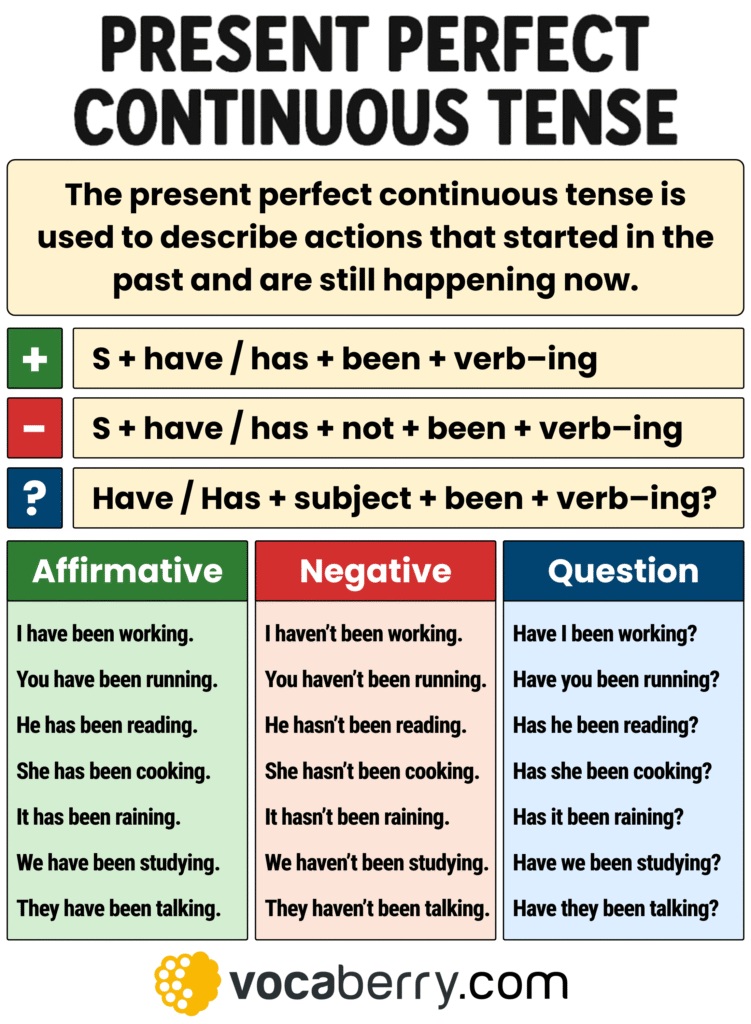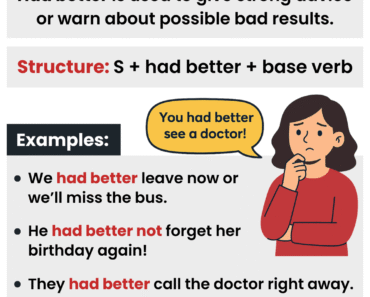
The present perfect continuous tense (also known as the present perfect progressive) is used to describe actions or events that began in the past and have continued up to now, and may still be happening. It emphasizes both the duration of the action and its ongoing nature, making it ideal for situations where the focus is on how long something has been happening.
In this lesson, you’ll learn how to form and use the present perfect continuous in affirmative, negative, and question forms, understand its structure and usage, review essential grammar rules, and explore common time expressions—all with clear examples.
When to Use the Present Perfect Continuous Tense
The present perfect continuous tense is used to describe actions that began in the past and continue into the present or were recently ongoing and still have an impact. This tense highlights how long an activity has been in progress and often emphasizes duration, repetition, or visible results in the present.
It’s typically used with expressions like “for,” “since,” “lately,” “recently,” “all day,” and “how long.”
1. Actions That Started in the Past and Continue Now
Used when the action began earlier and is still in progress at the time of speaking.
- I have been learning English for two years.
- She has been living in Berlin since 2021.
- We have been waiting for the bus for 30 minutes.
2. Recently Finished Actions with Present Results
Used when an activity has just ended but the effects or evidence are still visible or felt.
- I’m tired because I have been running.
- He has been painting the walls—look at the mess!
- You have been working all night. Get some rest!
3. Emphasizing Duration of Temporary Activities
Used for temporary or limited-time actions that are still happening or just stopped.
- They have been staying at a hotel this week.
- She has been reading that novel all afternoon.
- We have been using this room for our meetings lately.
4. Repeated or Ongoing Irritating Actions
Sometimes used to talk about actions that happen repeatedly and may cause frustration.
- He has been talking on the phone all morning!
- You have been interrupting me constantly.
- They have been borrowing my stuff without asking!
5. Asking How Long Something Has Been Happening
Used with “how long” to ask about the duration of a current action.
- How long have you been working here?
- How long has she been driving that car?
- Have they been watching the show since season one?
Present Perfect Continuous Tense Structure
The present perfect continuous tense is formed using have/has + been + present participle (verb+ing). This structure is used to show that an action started in the past and is still continuing or has recently stopped but still has a visible effect or relevance in the present.
This tense can be used in affirmative statements, negative sentences, questions, and short answers—all following a consistent form.
Affirmative Form
Use this form to describe ongoing or recently completed actions with present relevance.
Structure: Subject + have/has + been + verb-ing
Examples:
- I have been studying all evening.
- She has been working at the company since 2020.
- They have been playing soccer in the park.
Negative Form
Used to show that an ongoing activity has not been happening.
Structure: Subject + haven’t/hasn’t + been + verb-ing
Examples:
- I haven’t been sleeping well lately.
- He hasn’t been coming to class recently.
- They haven’t been using the printer.
Question Form
Use this to ask if an action has been ongoing or happening recently.
Structure: Have/Has + subject + been + verb-ing?
Examples:
- Have you been working out lately?
- Has she been feeling okay?
- Have they been arguing again?
Short Answers
For yes/no questions, we use short responses.
Examples:
- Have you been reading? → Yes, I have. / No, I haven’t.
- Has he been sleeping well? → Yes, he has. / No, he hasn’t.
- Have they been studying? → Yes, they have. / No, they haven’t.
Summary Table
| Type | Structure | Example |
|---|---|---|
| Affirmative | S + have/has + been + verb-ing | She has been practicing piano. |
| Negative | S + haven’t/hasn’t + been + verb-ing | I haven’t been feeling well. |
| Question | Have/Has + S + been + verb-ing? | Have they been waiting long? |
| Short Answer | Yes/No + S + have/has | Yes, she has. / No, she hasn’t. |
Time Expressions with the Present Perfect Continuous Tense
Here are the most common time expressions used with the present perfect continuous tense. These expressions usually refer to the duration, starting point, or recent activity. They help show how long something has been happening or whether the action is still ongoing or has just stopped.
They are especially useful for showing continuity, recent repetition, or unfinished actions.
| Time Expression | Example Sentence |
|---|---|
| for | She has been working for six hours without a break. |
| since | I have been learning Spanish since 2020. |
| lately | He has been feeling tired lately. |
| recently | We have been talking more recently. |
| all day | They have been studying all day for the exam. |
| all morning | I have been cleaning the kitchen all morning. |






